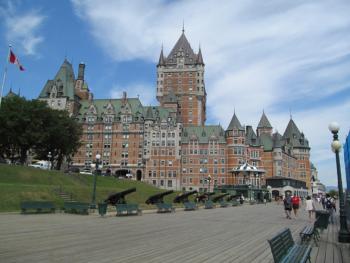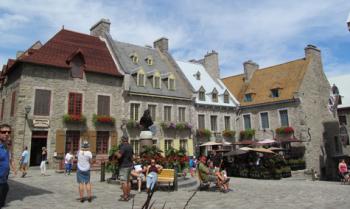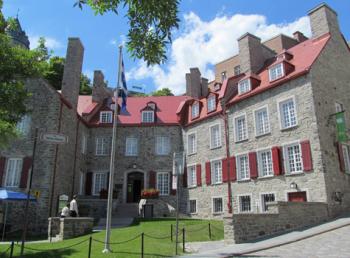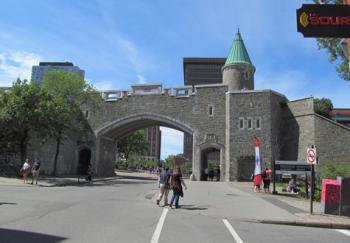Québec, capital of New France
This item appears on page 54 of the June 2017 issue.
Québec, capital of New France
Long before Samuel de Champlain founded Québec in 1608, Native Americans inhabited the area that was destined to become France’s toehold in the New World and, eventually, capital of New France. Among others, Algonquin, Huron and Iroquois lived in this area of eastern Canada beside the St. Lawrence since at least 5000 BC.
When Jacques Cartier arrived three-quarters of a century before Champlain, an Iroquois village occupied the site. By the time Champlain arrived, the Indian village no longer existed, but Champlain selected the site as his habitation (dwelling place).
This habitation was to serve as fortress, fur-trading post and residence until a larger stone structure was built in 1623, approximately where the Place-Royale now stands in Québec’s Lower Town.
First settlers
The earliest settlers — mostly merchants and fur traders — lived in Québec’s Lower Town, a narrow strip of land bordered by the St. Lawrence River on one side and a steep cliff on the other. The Upper Town atop the cliff became home to both government offices and religious institutions.
Hostilities between the British and French, smoldering for decades, culminated in the Battle of the Plains of Abraham in 1759 in which the British defeated the French, an event the Québécois still refer to as the “Conquest.”
Conquest or not, Canada was a dominion of the United Kingdom until 1982. However, Québec Province, one of Canada’s 10 provinces, is still decidedly French in feel, with some 95% of the population speaking French as either a first or second language.
It is the rich French heritage of Québec City that my husband, Paul, and I wanted to experience on our 17-day trip to the city in August 2016.
Basse-Ville
There is no better place to begin than where it all began 400-plus years ago: in the Basse-Ville (Lower Town) beside the river. Here is where visitors will find three highlights among the many buildings remaining from the 17th and 18th centuries.
There is the rue du Petit-Champlain, the cobblestone pedestrian street lined with shops, galleries and cafés that is the oldest street in the city, dating from the 1680s.
Close by, at 50 rue du Marché-Champlain, is the majestic Maison Chevalier complex, three buildings erected between 1675 and 1752. They are distinguished by, on the outside, stone walls, tall chimneys and steeply sloping roofs and, on the inside, wood beams, stone fireplaces and vaulted cellars. The rooms house old Québec furniture, including detailed, completely furnished, doll-house-size rooms.
Around the corner is Place-Royale, an atmospheric square lined with Normandy-style houses. The stone Église Notre-Dame-des-Victoires (Church of Our Lady of Victories), built between 1688 and 1723, is where Champlain’s habitation once stood. The square in front of the church is where the habitation’s garden was located 400 years ago.
On the Place-Royale is the Musée de la Place-Royale, with a scale model of what the city looked like in 1635. In the large, vaulted cellars are fun period costumes to try on.
What I love most about the Lower Town, however, is wandering its streets admiring the architecture and stopping frequently at any of the many colorful cafés.
Haute-Ville
It’s a very long hike or a very short funicular ride up to the Haute-Ville (Upper Town), where there is so much to see that picking out highlights is difficult.
Next to the iconic Château Frontenac, the castle-like hotel that opened in 1893, is the 1620 Place d’Armes, once a military parade ground, as well as the remnants of Saint-Louis Fort and Château (1620-1834) on view below the boardwalk in front of the Château Frontenac.
There are four religious institutions — all dating from the 17th century — that shouldn’t be missed: the Ursuline and Augustine convents; the Old Seminary, and the Basilica-Cathedral of Notre-Dame-de-Québec, on the spot where Champlain built the city’s first church in 1647.
The highlight, though, among highlights are the fortifications surrounding the Upper Town: the walls, ramparts, gateways and Artillery Park, with barracks. There’s also the Citadel, which is a superb example of French military architecture, modeled on forts built by the Marquis of Vauban, engineer to French King Louis XIV.
Québec City is the only city in North America to have preserved its fortifications, which now enclose almost three miles of the Upper Town.
As with the Lower Town, the greatest pleasure of the Upper Town is strolling its streets admiring the centuries-old architecture. The Upper Town and the Lower Town comprise a UNESCO World Heritage Site.
Native people’s village
Also not to be missed is a visit to Wendake, the reserve that is home to the Huron-Wendat people, who inhabited this part of Canada long before Europeans arrived.
It’s located 11 miles from Québec City. There’s a bus available on a regular schedule, the Wendake Express (418/664-0460), to take you there. Visitors can spend a day, as we did, visiting the excellent museum, watching traditional dance, exploring traditional buildings like the longhouse, smokehouse and sweat lodge and dining at either La Traite or Nek8arre restaurants on authentic native people’s cuisine like sunflower soup, banique (bread made from wheat) or wild game.
Next to La Traite restaurant is a spectacular hotel (www.hotel
premieresnations.ca) shaped like an immense longhouse, for those who want to linger a night or two.
Additional information about Wendake can be found at www.tourismewendake.ca and www.huron-wendat.qc.ca.
Five-star museums
Also on the top of my to-see list were two superb museums: the Museum of Civilization (www.mcq.org/en) at 85 rue Dalhousie in Lower Town, with a first-rate exhibit on Native Americans (plus a lot more), and the Québec Museum of Fine Arts (www.mnbaq.org/en) in Battlefields Park, housing the spectacular Brousseau Collection of Inuit Art, one of the best such collections I’ve ever seen.
There are three pavilions in all making up the Fine Arts Museum: historical, contemporary and modern art.
If you go…
Our home in Québec City for 17 nights was Les Lofts 1048 (418/657-9177, www.condovieuxquebec.ca/en/les-lofts-1048), located at 1048 rue Saint-Jean in the Upper Town.
Les Lofts 1048 is a collection of six stylish, loft-style apartments in a former commercial building steps away from the Saint-Jean Gate. Amenities include air-conditioning, Wi-Fi, washer/dryer, dishwasher, microwave, elevator and rooftop terrace. The location is perfect.
The cost for our 2-bedroom, 2-bathroom apartment, No. 202, was CAD250 (near $185) per night during high season.
Editor's note: Regarding the author's use of the term "Native Americans" in the above article, please see the comments in the "Boarding Pass" column in the August 2017 issue.





